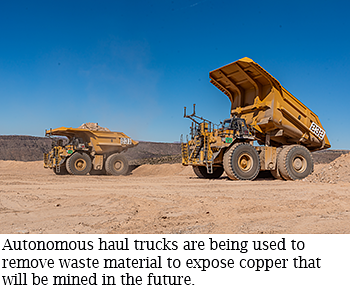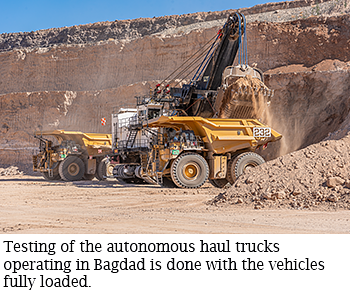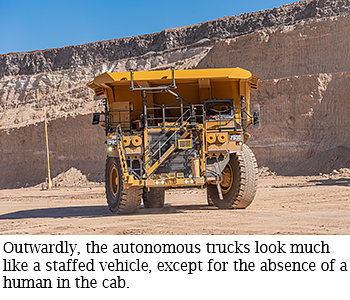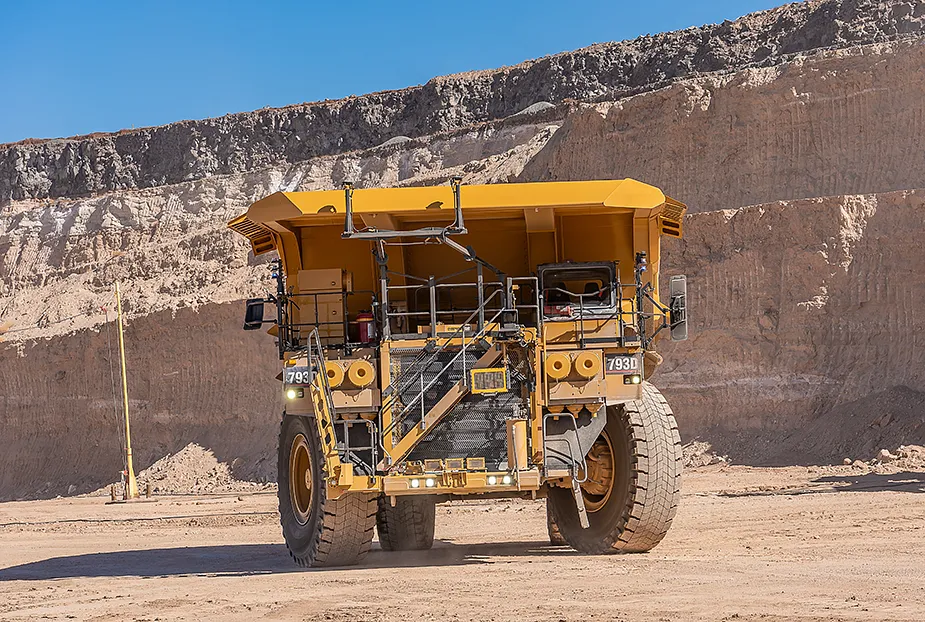Driverless haul trucks are moving material at Bagdad.
Starting with the Monday morning shift, the first four autonomous trucks began round-the-clock production, culminating more than a year-and-a-half of planning, construction and training following Freeport’s July 2023 announcement of a planned transition to self-driving trucks at the site.
 This week’s go-live is part of the conversion that is expected to have the site’s entire haulage fleet of 33 trucks running autonomously by year end. During this initial startup phase, the trucks are being tested and tweaked. The people who will oversee their operation already have undergone extensive training and are gaining real-world experience with the new technology.
This week’s go-live is part of the conversion that is expected to have the site’s entire haulage fleet of 33 trucks running autonomously by year end. During this initial startup phase, the trucks are being tested and tweaked. The people who will oversee their operation already have undergone extensive training and are gaining real-world experience with the new technology.
“The significance of the Bagdad Autonomous Haulage System project cannot be overstated,” said Jeff Monteith, General Manager-Bagdad. “It is a game changer for Bagdad and Freeport. I could not be happier with the performance of the BAHS Team.”
The first two autonomous trucks began receiving their first loads of materials on February 11 as part of a final test run. Since then, the trucks had been picking up full loads at a shovel, transporting them to the waste dump and unloading them at the designated spot without a person in the cab. The second two trucks joined the operation for full-time service on Monday.
There have been some bugs to work out, but no big surprises, said Mark Elliott, Project Manager, Engineering II. The trucks are operating in an isolated autonomous zone, separated from the staffed haul trucks and other site operations. Anyone entering the zone has undergone specialized training on interacting with the autonomous vehicles, including shovel operators and people in light vehicles. Ultimately, anyone entering the mine area will receive that training as the site transitions to fully autonomous haulage.
 By May, it is expected about a dozen autonomous trucks will be in use. The full haulage fleet is scheduled to be autonomous by the end of the year.
By May, it is expected about a dozen autonomous trucks will be in use. The full haulage fleet is scheduled to be autonomous by the end of the year.
“Every week, we are getting more familiar and capable with the system,” Elliott said. “I knew we would have some challenges when we turned the system on because it’s learning a new system, learning a new way of operating these trucks compared to a staffed environment. The team has been exceptionally resilient with troubleshooting and getting the system up and running.”
Support team in place
With only four trucks operating, staffing includes one supervisor, one controller who manages the digital system that tells the trucks what to do, one pit technician who surveys conditions in the real world, and one builder who takes that information and uses it to create a virtual world. Caterpillar, which manufacturers the autonomous technology, also has an application specialist on every shift.
 When 33 trucks are operating, each shift crew will include one supervisor, two controllers, one builder, and a Caterpillar specialist. There also will be four pit technicians and a maintenance dispatcher who will monitor the condition of the vehicles and equipment through the Remote Access Monitoring Process, which uses onboard sensors to continually track vehicle performance.
When 33 trucks are operating, each shift crew will include one supervisor, two controllers, one builder, and a Caterpillar specialist. There also will be four pit technicians and a maintenance dispatcher who will monitor the condition of the vehicles and equipment through the Remote Access Monitoring Process, which uses onboard sensors to continually track vehicle performance.
The people who will fill those roles are being rotated in from their regular duties to gain experience with the autonomous system. When fully operational, there will be four crews operating continuously.
The results of the early operation have been positive, Elliott said. As people get more familiar with the technology, vehicle system startup times are improving and production is increasing.
There are some quirks. For instance, if there is a small material spill on a haul road a driver would normally report it and just go around until it gets cleaned up. An autonomous vehicle will not do that. It will just stop.
“The beautiful thing about autonomous trucks is they do exactly what they’re supposed to do,” Elliott said. “But that’s also a flaw because if anything doesn’t happen how it’s supposed to, those trucks may not operate. So, autonomy has the ability to show different inefficiencies because a staffed operator will just make a decision whereas the autonomous system is not capable of that. They do what they’re programmed to do.”
